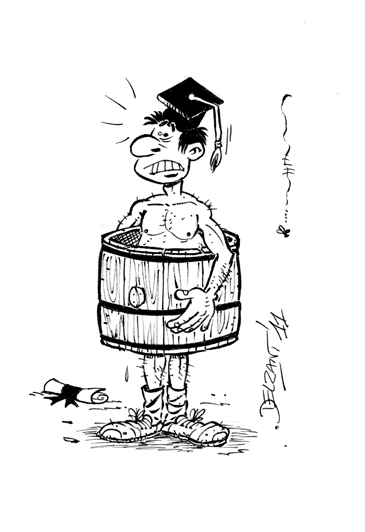When I first went to college – Fall 1988, UMass Amherst – the cost of my tuition and all those lovely extra fees came to the princely total of about $5,000. Room and board was roughly $3,000. When I came to UMass Boston to finish my undergraduate degree – Spring 2010 – the tuition and fees had gone up to about $11,000 a year, with room and board catch-as-catch-can. This may seem like a big jump, but it’s even worse at private schools. My sister went to Brandeis. For her final year, 1988, everything including room and board cost about $20,000. This year, the same Brandeis experience would cost over $55,000 with a private room, or a thousand less with a roommate.
While the cost of attending college has gone up faster than the rate of inflation, aid to students has not. A full Pell Grant, initially suitable for covering most costs of even many private schools, now barely covers half the cost of UMass Boston for one year. Students needing help have turned increasingly to loans, borrowing more and more money to get their coveted sheepskins. As loans have gotten higher and higher, more and more students have ended up defaulting on their loans, hurting their credit and jeopardizing their financial futures. In fact, the rate of default in just the first two years after college has nearly doubled, from 4.5% to 8.8%. General default rates have gone up as well, as increasingly-underpaid college graduates have gotten further and further behind on bills. In short, this hurts; and in this economy, with huge job uncertainty and depressed wages, it’s only getting worse.
If we really want a more educated society, we need to invest more in our students and schools. This might be tricky, though. The GOP keeps talking about cutting Pell Grants and hint at returning the federal student loan program to an expensive giveaway for privately-owned banks – which, I might add, would drive up the default rate.
To truly expand on higher education, we need to invest more in public colleges and universities and invest more in our students. I doubt we could get a Swedish system of free public universities for all citizens who want to go, but we should at least do something close to it. Expanding the Pell Grant program to help more students and give bigger grants would be a start. Federal investment in both infrastructure and tuition reduction would reduce student costs and provide more access for more prospective students. If the GOP insists on a merit-based program, then high-school seniors and current college students who maintain a 3.0 could get an extra merit-based grant for each semester. Expanded benefits from AmeriCorps and the GI Bill would mean more desperately-needed public service workers. This could all be funded with 1-2% of the current federal budget, and paid for by ending the high-end Bush tax cuts.
I’ve heard talk about student public loan forgiveness. I’ll be honest: I’d love that, but I have irons in that fire. More to the point, the GOP would rather cut tax receipts by $140 billion a year by cutting marginal tax rates on the richest to 25% than forgive even a penny of current crushing debt on students. It doesn’t matter that students and graduates would have more money to spend and help nudge the economy back into shape, or that cutting those taxes might bankrupt our government. It only matters that most of us aren’t rich enough to buy the GOP.





















































